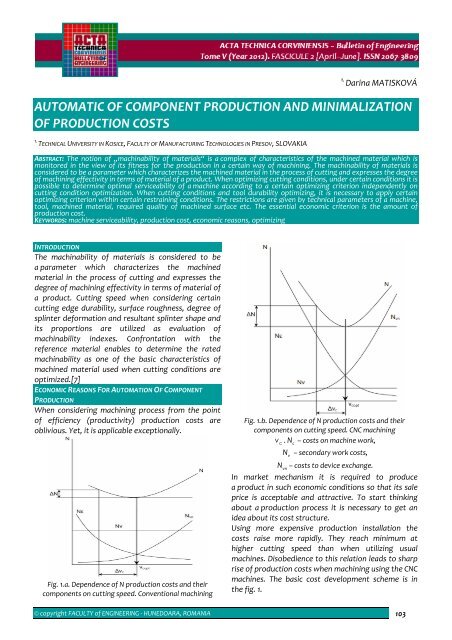Editorial & Advisory Board - Acta Technica Corviniensis
Editorial & Advisory Board - Acta Technica Corviniensis
Editorial & Advisory Board - Acta Technica Corviniensis
Create successful ePaper yourself
Turn your PDF publications into a flip-book with our unique Google optimized e-Paper software.
1.<br />
Darina MATISKOVÁ<br />
AUTOMATIC OF COMPONENT PRODUCTION AND MINIMALIZATION<br />
OF PRODUCTION COSTS<br />
1.<br />
TECHNICAL UNIVERSITY IN KOSICE, FACULTY OF MANUFACTURING TECHNOLOGIES IN PRESOV, SLOVAKIA<br />
ABSTRACT: The notion of „machinability of materials“ is a complex of characteristics of the machined material which is<br />
monitored in the view of its fitness for the production in a certain way of machining. The machinability of materials is<br />
considered to be a parameter which characterizes the machined material in the process of cutting and expresses the degree<br />
of machining effectivity in terms of material of a product. When optimizing cutting conditions, under certain conditions it is<br />
possible to determine optimal serviceability of a machine according to a certain optimizing criterion independently on<br />
cutting condition optimization. When cutting conditions and tool durability optimizing, it is necessary to apply certain<br />
optimizing criterion within certain restraining conditions. The restrictions are given by technical parameters of a machine,<br />
tool, machined material, required quality of machined surface etc. The essential economic criterion is the amount of<br />
production cost.<br />
KEYWORDS: machine serviceability, production cost, economic reasons, optimizing<br />
INTRODUCTION<br />
The machinability of materials is considered to be<br />
a parameter which characterizes the machined<br />
material in the process of cutting and expresses the<br />
degree of machining effectivity in terms of material of<br />
a product. Cutting speed when considering certain<br />
cutting edge durability, surface roughness, degree of<br />
splinter deformation and resultant splinter shape and<br />
its proportions are utilized as evaluation of<br />
machinability indexes. Confrontation with the<br />
reference material enables to determine the rated<br />
machinability as one of the basic characteristics of<br />
machined material used when cutting conditions are<br />
optimized.[7]<br />
ECONOMIC REASONS FOR AUTOMATION OF COMPONENT<br />
PRODUCTION<br />
When considering machining process from the point<br />
of efficiency (productivity) production costs are<br />
oblivious. Yet, it is applicable exceptionally.<br />
Fig. 1.a. Dependence of N production costs and their<br />
components on cutting speed. Conventional machining<br />
Fig. 1.b. Dependence of N production costs and their<br />
components on cutting speed. CNC machining<br />
v . N – costs on machine work,<br />
c<br />
c<br />
N<br />
v<br />
– secondary work costs,<br />
N<br />
vn<br />
– costs to device exchange.<br />
In market mechanism it is required to produce<br />
a product in such economic conditions so that its sale<br />
price is acceptable and attractive. To start thinking<br />
about a production process it is necessary to get an<br />
idea about its cost structure.<br />
Using more expensive production installation the<br />
costs raise more rapidly. They reach minimum at<br />
higher cutting speed than when utilizing usual<br />
machines. Disobedience to this relation leads to sharp<br />
rise of production costs when machining using the CNC<br />
machines. The basic cost development scheme is in<br />
the fig. 1.<br />
© copyright FACULTY of ENGINEERING ‐ HUNEDOARA, ROMANIA 103

















